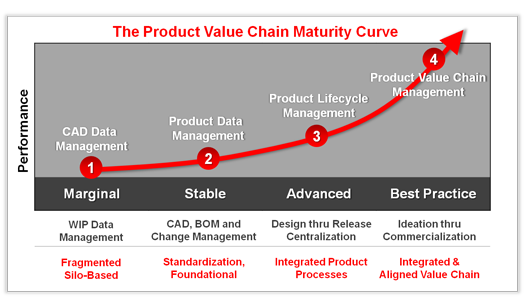The Complementary Roles of PLM and PIM
Posted
by Ulf Köster
on Oracle Blogs
See other posts from Oracle Blogs
or by Ulf Köster
Published on Wed, 20 Aug 2014 10:35:49 +0000
Indexed on
2014/08/20
16:29 UTC
Read the original article
Hit count: 776
/Oracle/Modules/All PLM
Oracle Product Value Chain Solutions (aka Enterprise PLM Solutions) are a comprehensive set of product management solutions that work together to provide Oracle customers with a broad array of capabilities to manage all aspects of product life: innovation, design, launch, and supply chain / commercialization processes beyond the capabilities and boundaries of traditional engineering-focused Product Lifecycle Management applications. They support companies with an integrated managed view across the product value chain: From Lab to Launch, From Farm to Fork, From Concept to Product to Customer, From Product Innovation to Product Design and Product Commercialization.

Product Lifecycle Management (PLM) represents a broad suite of software solutions to improve product-oriented business processes and data. PLM success stories prove that PLM helps companies improve time to market, increase product-related revenue, reduce product costs, reduce internal costs and improve product quality. As a maturing suite of enterprise solutions, PLM is still evolving to realize the promise it can provide across all facets of a business and all phases of the product lifecycle. The vision for PLM includes everything from gathering early requirements for a product through multiple stages of the product lifecycle from product design, through commercialization and eventual product retirement or replacement. In discrete or process industries, PLM is typically more focused on Product Definition as items with respect to the technical view of a material or part, including specifications, bills of material and manufacturing data. With Agile PLM, this is specifically related to capabilities addressing Product Collaboration, Governance and Compliance, Product Quality Management, Product Cost Management and Engineering Collaboration. PLM today is mainly addressing key requirements in the early product lifecycle, in engineering changes or in the “innovation cycle”, and primarily adds value related to product design, development, launch and engineering change process. In short, PLM is the master for Product Definition, wherever manufacturing takes place.
Product Information Management (PIM) is a product suite that has evolved in parallel to PLM. Product Information Management (PIM) can extend the value of PLM implementations by providing complementary tools and capabilities. More relevant in the area of Product Commercialization, the vision for PIM is to manage product information throughout an enterprise and supply chain to improve product-related knowledge management, information sharing and synchronization from multiple data sources. PIM success stories have shown the ability to provide multiple benefits, with particular emphasis on reducing information complexity and information management costs. Product Information in PIM is typically treated as the commercial view of a material or part, including sales and marketing information and categorization. PIM collects information from multiple manufacturing sites and multiple suppliers into its repository, but also provides integration tools to push the information back out to the other systems, serving as an active central repository with the aim to provide a holistic view on any product sold by a company (hence the name “Product Hub”). In short, PIM is the master of commercial Product Information. So PIM is quickly becoming mandatory because of its value in optimizing multichannel selling processes and relationships with customers, as you can see from the following table:
|
Viewpoint |
PLM Current State |
PIM |
Key Benefits PIM |
|
Product Lifecycle |
Primarily R&D |
Primarily commercial / |
Provides a seamless |
|
Data |
Primarily focused on “item” vs. “product” data |
Repository for all product information. |
Provides a “trusted source” of accurate product information to |
|
Data Lifecycle |
Repository for all design |
Released, current information, with version management and time stamping |
Provides a single location to track and audit historical product information |
|
Communication |
PLM release finished product to ERP |
Captures information from disparate sources, including in-house data stores |
Provides the ability to package product information to its audience in the desired, relevant format to meet their exacting business requirements |
|
Departmental |
R&D |
Focus on Marketing and Sales |
A singular enterprise solution that leverages existing information silos and data stores |
|
Supply Chain |
Multi-site internal collaboration |
Works with customers, exchanges / data pools, and trading partners to provide relevant product information packaged the way the customer desires |
Provides ability to provide trading partners and internal customers with information in a manner they desire, continuously |
|
Tools |
Data Management |
Cleansing |
Consistent, clean and complete commercial product information |
The goals of both PLM and PIM, put simply, are to help companies make more profit from their products. PLM and PIM solutions can be easily added as they share some of the same goals, while coming from two different perspectives: the definition of the product and the commercialization of the product. Both can serve as a form of product “system of record”, but take different approaches to delivering value. Oracle Product Value Chain solutions offer rich new strategies for executives to collectively leverage Agile PLM, Product Data Hub, together with Enterprise Data Quality for Products, and other industry leading Oracle applications to achieve further incremental value, like Oracle Innovation Management. This is unique on the market today.
© Oracle Blogs or respective owner